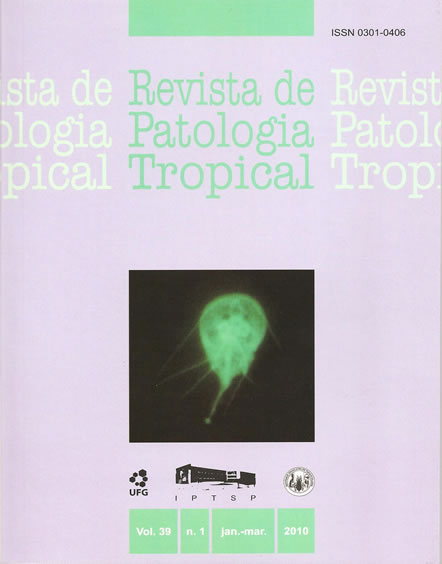Biological behavior of Leishmania (L.) amazonensis isolated from a cat (Felis catus) from Mato Grosso do Sul State, Brazil
DOI:
https://doi.org/10.5216/rpt.v39i1.9496Keywords:
Leishmania amazonensis, Cat, Murine model, Histopathology.Abstract
Even though the main mammalian reservoirs of Leishmania described in theAmericas are rodents, opossums, horses, canines, and primates, the role of the cat
as a host of Leishmania has also been discussed. This work was performed in order
to study the histopathology of cutaneous lesions of mice infected with Leishmania
(L.) amazonensis isolated from a cat in Ribas do Rio Pardo, Mato Grosso do Sul,
Brazil. The histopathological analysis comprised an assessment of the intensity
and composition of the inflammatory infiltrate, as well as parasite load. Mice
exhibited a high degree of cutaneous parasitism in the paw, at 20 days post infection, demonstrating the high and rapid infectivity of the sample isolated from the cat. An intense and diffuse lymphohistiocytic, eosinophilic inflammatory infiltrate and
a diffuse, moderate necrosis were observed at the site of infection. It is important
to note that the original cat presented no sign of immunosuppressive disease. The
occurrence of visceralization was not observed, since no parasites were found in the
liver or spleen 60 days after infection. Nonetheless, the liver presented focal and
perivascular inflammatory reactions.
Downloads
Downloads
Published
How to Cite
Issue
Section
License
The manuscript submission must be accompanied by a letter signed by all authors stating the full name and email address, confirming that the material has not been published or is under consideration for publication elsewhere, and agreeing to transfer copyright in all media and formats for Journal of Tropical Pathology. The authors will not be paid for published articles. They are solely responsible for the content of those articles, even if the Editor holds the right to adjust them to the norms of the journal.
The reviewers will not be paid for the peer review process.

